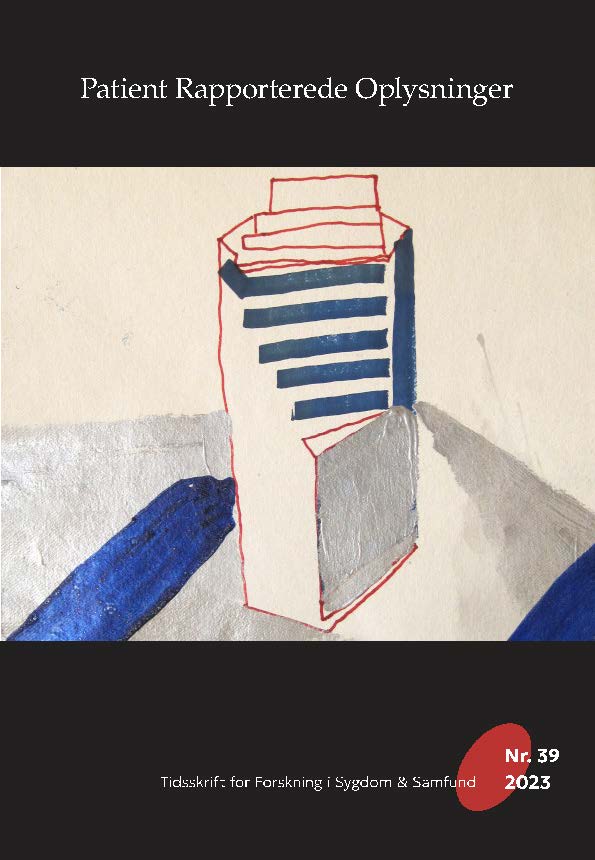Essays
Publiceret 2023-12-07
Citation/Eksport
Nielsen, A. S. (2023). Undgå at digitale PRO-skemaer bidrager til ulighed. Tidsskrift for Forskning I Sygdom Og Samfund, 21(39). https://doi.org/10.7146/tfss.v21i39.133861
Referencer
- Appel, Charlotte W., Sarah Pedersen, Amalie Søgaard Nielsen, and Birgit Furstrand. 2022. “Telemedicine Based on Patient-Reported Outcomes in Management of Patients with Inflammatory Bowel Disease in a Real-Life Setting – a before and after Cohort Study.” Scandinavian Journal of Gastroenterology (IGAS). https://doi.org/10.1080/00365521.2022.2041083.
- Digitaliseringsstyrelsen, and KL. 2021. “Digital Inklusion i Det Digitaliserede-Samfund.” 2021. https://digst.dk/media/24389/digital-inklusion-i-det-digitaliserede-samfund.pdf.
- Eiriksson, Birgitte Arent. 2022. “Retssikkerhed for digitalt udsatte borgere.” Justitia.
- Greenhalgh, Joanne. 2009. “The Applications of PROs in Clinical Practice: What Are They, Do They Work, and Why?” Quality of Life Research 18 (1): 115–23. https://doi.org/10.1007/s11136-008-9430-6.
- Hjollund, Niels Henrik Ingvar. 2017. “Individual Prognosis of Symptom Burden and Functioning in Chronic Diseases: A Generic Method Based on Patient-Reported Outcome (PRO) Measures.” Journal of Medical Internet Research 19 (8): e278. https://doi.org/10.2196/jmir.8111.
- Ishaque, S., J. Karnon, G. Chen, R. Nair, and A. B. Salter. 2018. “A Systematic Review of Randomised Controlled Trials Evaluating the Use of Patient-Reported Outcome Measures (PROMs).” Quality of Life Research, October. https://doi.org/10.1007/s11136-018-2016-z.
- Mejdahl, Caroline Trillingsgaard, Liv Marit Valen Schougaard, Niels Henrik Hjollund, Erik Riiskjær, and Kirsten Lomborg. 2018. “Exploring Organisational Mechanisms in PRO-Based Follow-up in Routine Outpatient Care - an Interpretive Description of the Clinician Perspective.” BMC Health Services Research 18 (1): 546. https://doi.org/10.1186/s12913-018-3352-y.
- Mejdahl, Caroline Trillingsgaard, Liv Marit Valen Schougaard, Niels Henrik Hjollund, Erik Riiskjær, Sally Thorne, and Kirsten Lomborg. 2018. “PRO-Based Follow-up as a Means of Self-Management Support – an Interpretive Description of the Patient Perspective.” Journal of Patient-Reported Outcomes 2 (1): 38. https://doi.org/10.1186/s41687-018-0067-0.
- Nguyen, Hanh, Phyllis Butow, Haryana Dhillon, and Puma Sundaresan. 2020. “A Review of the Barriers to Using Patient-Reported Outcomes (PROs) and Patient-Reported Outcome Measures (PROMs) in Routine Cancer Care.” Journal of Medical Radiation Sciences, August. https://doi.org/10.1002/jmrs.421.
- Nielsen, Amalie Søgaard, Charlotte W. Appel, Birgit Furstrand Larsen, Lisa Hanna, and Lars Kayser. 2022. “Digital Patient-Reported Outcomes in Inflammatory Bowel Disease Routine Clinical Practice: The Clinician Perspective.” Journal of Patient-Reported Outcomes 6 (1): 52. https://doi.org/10.1186/s41687-022-00462-x.
- Nielsen, Amalie Søgaard, Charlotte W. Appel, Birgit Furstrand Larsen, Lars Kayser, and Lisa Hanna. 2021. “Patient Perspectives on Digital Patient Reported Outcomes in Routine Care of Inflammatory Bowel Disease.” Journal of Patient-Reported Outcomes 5 (1): 92. https://doi.org/10.1186/s41687-021-00366-2.
- Nielsen, Amalie Søgaard, Kristian Kidholm, and Lars Kayser. 2020. “Patients’ Reasons for Non-Use of Digital Patient-Reported Outcome Concepts: A Scoping Review.” Health Informatics Journal 26 (4): 2811–33. https://doi.org/10.1177/1460458220942649.
- Norgaard, Ole, Dorthe Furstrand, Louise Klokker, Astrid Karnoe, Roy Batterham, Lars Kayser, and Richard H. Osborne. 2015. “The E-Health Literacy Framework: A Conceptual Framework for Characterizing e-Health Users and Their Interaction with e-Health Systems.” Knowledge Management & E-Learning 2015.
- Ragnedda, Massimo. 2017. “The Third Digital Divide: A Weberian Approach to Digital Inequalities.” Routledge & CRC Press. 2017. https://www.routledge.com/The-Third-Digital-Divide-A-Weberian-Approach-to-Digital-Inequalities/Ragnedda/p/book/9781138346932.
- Schougaard, Liv Marit Valen, Caroline Trillingsgaard Mejdahl, Jakob Christensen, Kirsten Lomborg, Helle Terkildsen Maindal, Annette de Thurah, and Niels Henrik Hjollund. 2019. “Patient-Initiated versus Fixed-Interval Patient-Reported Outcome-Based Follow-up in Outpatients with Epilepsy: A Pragmatic Randomized Controlled Trial.” Journal of Patient-Reported Outcomes 3 (1): 61. https://doi.org/10.1186/s41687-019-0151-0.
- Skovlund, Søren Eik, Antonio Nicolucci, Nina Balk-Møller, Dorthe B. Berthelsen, Charlotte Glümer, Hans Perrild, Pernille Kjær, et al. 2021. “Perceived Benefits, Barriers, and Facilitators of a Digital Patient-Reported Outcomes Tool for Routine Diabetes Care: Protocol for a National, Multicenter, Mixed Methods Implementation Study.” JMIR Research Protocols 10 (9): e28391. https://doi.org/10.2196/28391.
- Torenholt, Rikke, Lena Saltbæk, and Henriette Langstrup. 2020. “Patient Data Work: Filtering and Sensing Patient-Reported Outcomes.” Sociology of Health & Illness 42 (6): 1379–93. https://doi.org/10.1111/1467-9566.13114.

